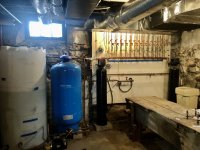matthew higdon
New Member
That's it, but you may be able to set the current to detect when the pump is almost ready to run out of water. The box displays the current. When the water level drops, the current drops gradually before you run out of water. Then the current drops a lot when you actually run out. You adjust the setpoint as to what current to shut down at.
Want to see the current drop with your current configuration? Clip a clamp-around ammeter around one of your hot wires at the breaker panel, or pressure switch -- whatever is accessible .
With the SQ pump, no control box.
sorry, what do you mean by control box? please don't confuse me by swapping around terminology.
i do have a digital multi-meter. just not sure if it has ammeter function. if not, i'm sure my neighbor has one
and, this method of operation with the cycle sensor is safe/not hard on equipment? i hope you understand my concerns as this, to me, seems a bit of a kludge way of getting the same job done given it's a "fault" operation. i mean, i get how the timer set up is not exactly "safe" (though it has been performing reliably over these years), but i've also had to best guess the recovery rate when that's a fluctuating variable. so, there's that. perhaps that's not so much of an issue with the cycle sensor, though?
Last edited:

